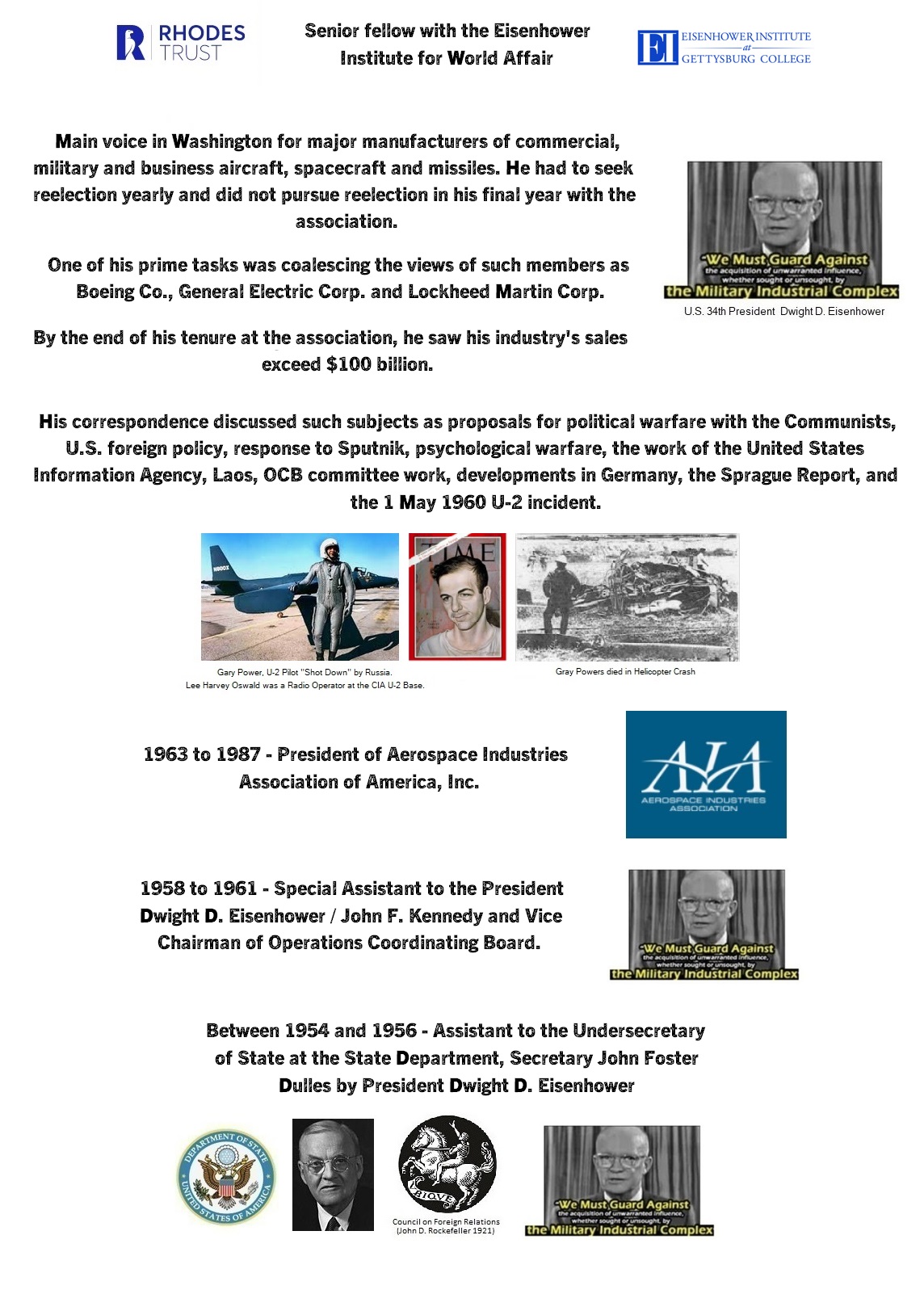
Karl Gottlieb Harr, Jr. (Rhodes 1948)
Princeton University. University of Oxford, Rhodes Scholar. Yale Law School. Phi Beta Kappa. Metropolitan Club. Chevy Chase Club.
Throughout his professional life, Harr corresponded with a number of prominent individuals…[9]
Some of his correspondents include Nelson Rockefeller, Charles Douglas Jackson (CIA, Life Magazine, Operation Mockingbird], David Sarnoff (Freemason, Titanic, Marconi checking for survivor updates), Walter Bedell Smith[CIA Director, employed by Morehead Patterson S&B 1920] , William Kintner, Hubert Humphrey (Phi Delta Chi), Townsend Hoopes [S&B 1944], Robert Cutler, Robert Bowie, T. Keith Glennan (Chi Phi Fraternity, NASA, JPL, Western Electric, Yale) , Clarence B. Randall (Inland Steel), Lewis Strauss (Secretary of Commerce), Gordon Gray (Order of Gimghoul, Delta Kappa Epsilon, NSA, Counsel to President George H. W. Bush [S&B 1948]), and Walt Whitman Rostow [Rhodes].[9]
His correspondence discussed such subjects as proposals for political warfare with the Communists, U.S. foreign policy, response to Sputnik, psychological warfare, the work of the United States Information Agency, Laos, OCB committee work, developments in Germany, the Sprague Report, and the 1 May 1960 U-2 incident [involved Gary Powers, see header … Note, Lee Harvey Oswald was a radio operator at a CIA U-2 base in Japan where Gary Powers was stationed[9]]
Former board member of what was the Union Trust Co.[2]
In a career that spanned the better part of the Cold War, Mr. Harr played a major role in procurement and readiness during the space race with the Soviets in the 1960s and beyond.[2]
He was the main voice in Washington for major manufacturers of commercial, military and business aircraft, spacecraft and missiles. He had to seek reelection yearly and did not pursue reelection in his final year with the [Aerospace Industries] association.[2]
One of his prime tasks was coalescing the views of such members as Boeing Co., General Electric Corp. and Lockheed Martin Corp.[2]
By the end of his tenure at the association, he saw his industry’s sales exceed $100 billion.[2]
1989, he was named a senior fellow with the Eisenhower Institute for World Affairs.
1963 to 1987 - President of Aerospace Industries Association of America, Inc.
1958 to 1961 - Special Assistant to the President Dwight D. Eisenhower / John F. Kennedy and Vice Chairman of Operations Coordinating Board, which help carry out decisions made by the National Security Council.[2]
1956 to 1958, Defense Department Deputy Assistant Secretary for International Security Affairs, Secretary John Foster Dulles by President Dwight D. Eisenhower.[2]
Between 1954 and 1956 - Assistant to the Undersecretary of State at the State Department, Secretary John Foster Dulles (CFR. Pilgrims. Rockefeller Foundation) by President Dwight D. Eisenhower.
1954 - After working at a New York law firm, he came to Washington.[2]
1953, President Eisenhower’s Executive Order 10483 and tasked with oversight of U.S. covert operations. The creation of the board was a recommendation of the Jackson Committee, chaired by William Harding Jackson (Many Connections to S&B who financed Adolf Hitler and were also Bletchley Park in WW2)[4]. Abolished by President Kennedy on 19 Feb 1961, because it was thought that secret wars should not be overseen by so many officials.[5] By that time, much of OCB’s work was being continued by other bodies, such as the Planning Coordination Group (PCG), pursuant to presidential directive Covert Operations NSC 5412/12 in 1955, and by the Special Group[6]
1948 to ? - Rhodes Scholar, Oxford University.[2]
1948 - Graduated Yale University Law School.[2]
[2] - Washington Post.com - Aerospace Industry Leader Karl G. Harr
[4] - Eisenhower Presidential Center website.
[5] - Prados, John (2006), “Safe for Democracy: The Secret Wars of the CIA,” Ivan R. Dee, p. 150
[11] - Loss of Innocence: America’s Scandals in the Post-War Years By Melvin E. Matthews Jr.
[14] - Prologue: The Journal of the National Archives, Volume 27



Comments